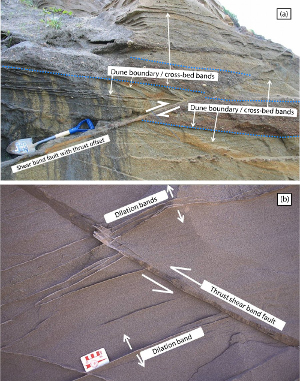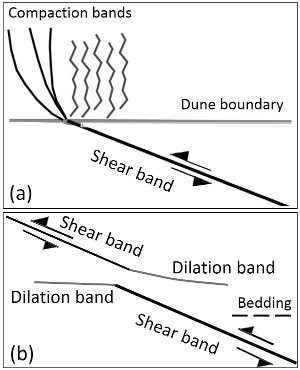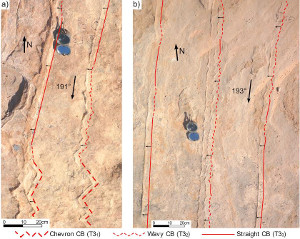|
Here are three examples. The first two (a and b of Figure 1) display splay dilation bands in poorly consolidated young terrace deposits near McKinleyville, northern California. This site has been described under case studies in more detail. Splay angles with respect to shear bands have been used to infer the mode of the splay band either as closure (Figure 2a from Mollema and Antonellini, 1996) or dilation (Figure 2b from Du Bernard et al., 2002).
 | | Figure 1. Shear bands and the associated splay dilation bands in poorly consolidated terrace deposits of 83 ka age near McKinleyville, northern California. (a) A shear band zone with a thrust offset of about 80 cm as evident by an offset conglomerate unit highlighted by dashed blue line boundaries; (b) a shear band zone and the associated splay dilation bands formed along the bedding. |
 | | Figure 2. (a) Map showing splay compaction bands associated with a shear band with thrust sense of displacement in the Navajo Sandstone exposed in the Kaibab monocline, Utah. From Mollema and Antonellini (1996). (b). Map showing shear bands with thrust sense of displacement and the associated splay bands with predominantly dilation. Simplified from Du Bernard et al. (2002) |
The next pair (a and b of Figure 3) are examples of splay compaction bands associated with possibly shear enhanced compaction band zones from the Valley of Fire State Park, southeastern Nevada (Hill, 1989; Eichhubl et al., 2010; and Deng and Aydin, 2012). Recently Liu et al. (2015) have investigated the shapes of the splay compaction bands in Valley of Fire and have proposed that the material properties dictated by the depositional process as well as the loading are critical for the formation of compaction bands in various shapes and their evolution from straight to wavy and eventually to chevron (Figure 4).
 | | Figure 3. (a) and (b) splay deformation bands (possibly compaction dominated) associated with shear enhanced compaction bands in sandstone, Valley of Fire State Park, Nevada. 1 and 2 are thought to be shear enhanced compaction band zones and set 3 is interpreted to be pure compaction band splays. |
 | | Figure 4. Annotated photographs showing splay compaction bands in Aztec Sandstone, Valley of Fire State Park, Nevada. From Liu et al. (2015). (a) The band shape varying gradually from chevron to wavy to straight. (b) Bands with different geometry from straight, wavy, and chevron. The authors propose that the band shape is controlled by local petrophysical properties of the deposit. |
| |
Deng, S., Aydin, A., 2012. Distribution of compaction bands in 3D in an aeolian sandstone: The role of cross-bed orientation. Tectonophysics 574–575: 204–218. http://dx.doi.org/10.1016/j.tecto.2012.08.037.
Du Bernard, X., Eichhubl, P., Aydin, A., 2002. Dilation bands: a new form of localized failure in granular media. Geophysical Research Letters 29 (24): 2176 doi: 1029/2002GLO15966.
Eichhubl, P., Hooker, J.N., Laubach, S.E., 2010. Pure and shear-enhanced compaction bands in Aztec Sandstone. Journal of Structural Geology 32: 1873 – 1886.
Hill, R.E., 1989. Analysis of deformation bands in the Aztec Sandstone, Valley of Fire State Park, Nevada. Master of Science thesis, University of Nevada, Las Vegas, 68p.
Liu, C., Pollard, D.D., Aydin, A., Deng, S., 2015. Mechanism of formation of wiggly compaction bands in porous sandstone: 1. Observations and conceptual model. Journal of Geophysical Research, Solid Earth 120: doi:10.1002/2015JB012372.
Mollema, P., Antonellini, M., 1996. Compaction bands: a structural analog for anti-mode I cracks in aeolian sandstone. Tectonophysics 267: 209-228.
|



